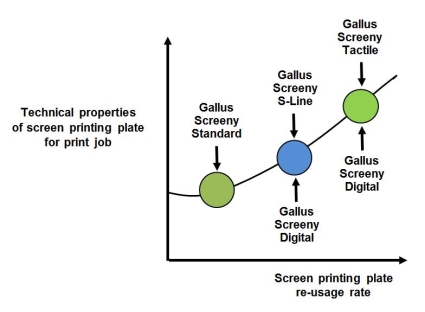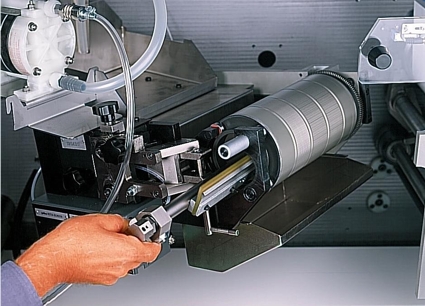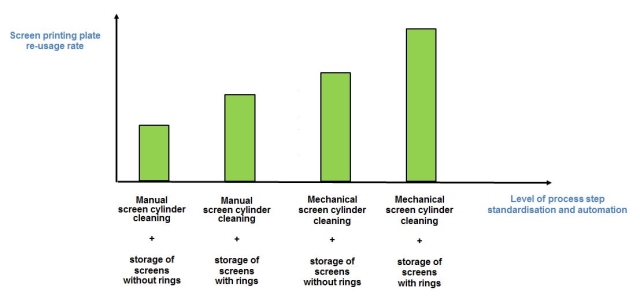Re-using screens is one of the most effective ways of cutting screen printing costs and is influenced by two parameters – matching the screen printing plate’s technical properties to the relevant application, and handling screen printing cylinders both inside and outside the press. Controlling these variables significantly reduces costs per screen printing label by achieving high re-usage rates.
Technical properties of Gallus Screeny screen printing plates
Selecting the appropriate screen printing plate with the right technical properties for the relevant print job is extremely important. Gallus Screeny screen printing plates consist of a nickel-galvanised steel fabric onto which a photopolymer layer is machined with the utmost precision. Different re-usage rates are achieved for the various types of screen printing plates depending on the combination of fabric structure, wire thickness, galvanised nickel layer, thickness and adhesion of the photopolymer layer. The extremely wide range of Gallus Screeny screen printing plates with different technical characteristics meets all the various printing and economic requirements.
Matching screen printing plate to print Jobs
Each print job places its own specific demands on a screen printing plate. Lower re-usage rates are entirely acceptable for print jobs with a probable change in print image. A screen printing plate such as the Gallus Screeny Standard is ideal in this case. For labels that are produced unchanged several times, however, the Gallus Screeny S-Line is the correct choice, because it is far more stable than the Standard generation.
Very high re-usage rates are also often achieved with Gallus Screeny Tactile. On the one hand, the tactile symbols and areas in the print image barely change and, on the other, Gallus Screeny Tactile screen printing plates have a thick photopolymer layer that gives the screen printing plate additional photopolymer protection.
Gallus Screeny Digital screen types are based on S-Line and Tactile technology, which enables them to achieve the same high cost-efficient re-usage rates.

Handling inside the press
Screen cylinder handling inside the press is a further important factor for achieving a high screen re-usage rate. The process steps and details that influence a printing screen’s service life include fitting the cylinder in the screen printing unit and removing it in the appropriate way for the relevant type, ideal setting of all print parameters based on the print job and optimum adjustment of the printing squeegee. The more often production staff perform these process steps in their everyday work, the more they become a matter of routine. If screen printing is a surface finishing method that is seldom used in day-to-day production, though, these steps should be practised from time to time. Our Gallus Screeny Service & Support team will be only too pleased to help you with this.

Handling outside the press
Outside the press, the screen cylinder re-usage rate is determined by various process steps that Gallus has automated to achieve higher rates.
If staff clean the screen cylinder manually, for example, they can easily damage it during this process. Automating cleaning minimises such damage. Once the number of screen printing jobs in a company’s production department reaches a certain level, it is essential to purchase a screen cylinder washing unit such as the one offered by Gallus (ID no. GL.0177400/00) so as to maximise the screen cylinder re-usage rate. It also makes economic sense to store screen cylinders with screen rings glued in place, as this prevents the rings coming loose and damaging the cylinders.

Making a start now is the most important Thing
No matter how many screen printing jobs your production department handles, there’s nothing to stop you significantly cutting your costs per screen printing label by starting to re-use screens straight away. The Gallus Screeny Service & Support team will be happy to help you make this decision, select the right screen printing plate for your particular application and organise training on screen cylinder handling both inside and outside the press. Please feel free to contact us for any help and advice you may need.